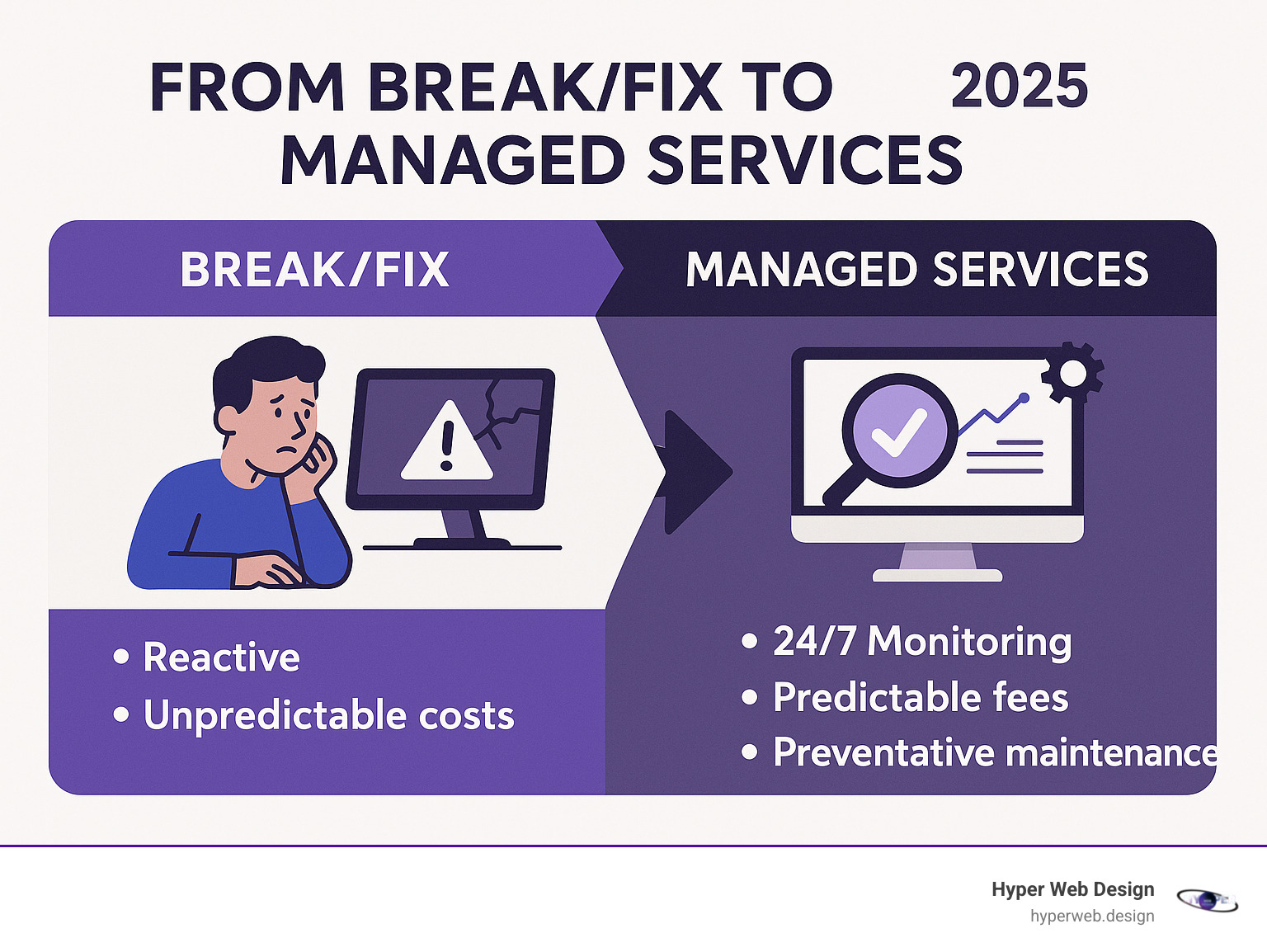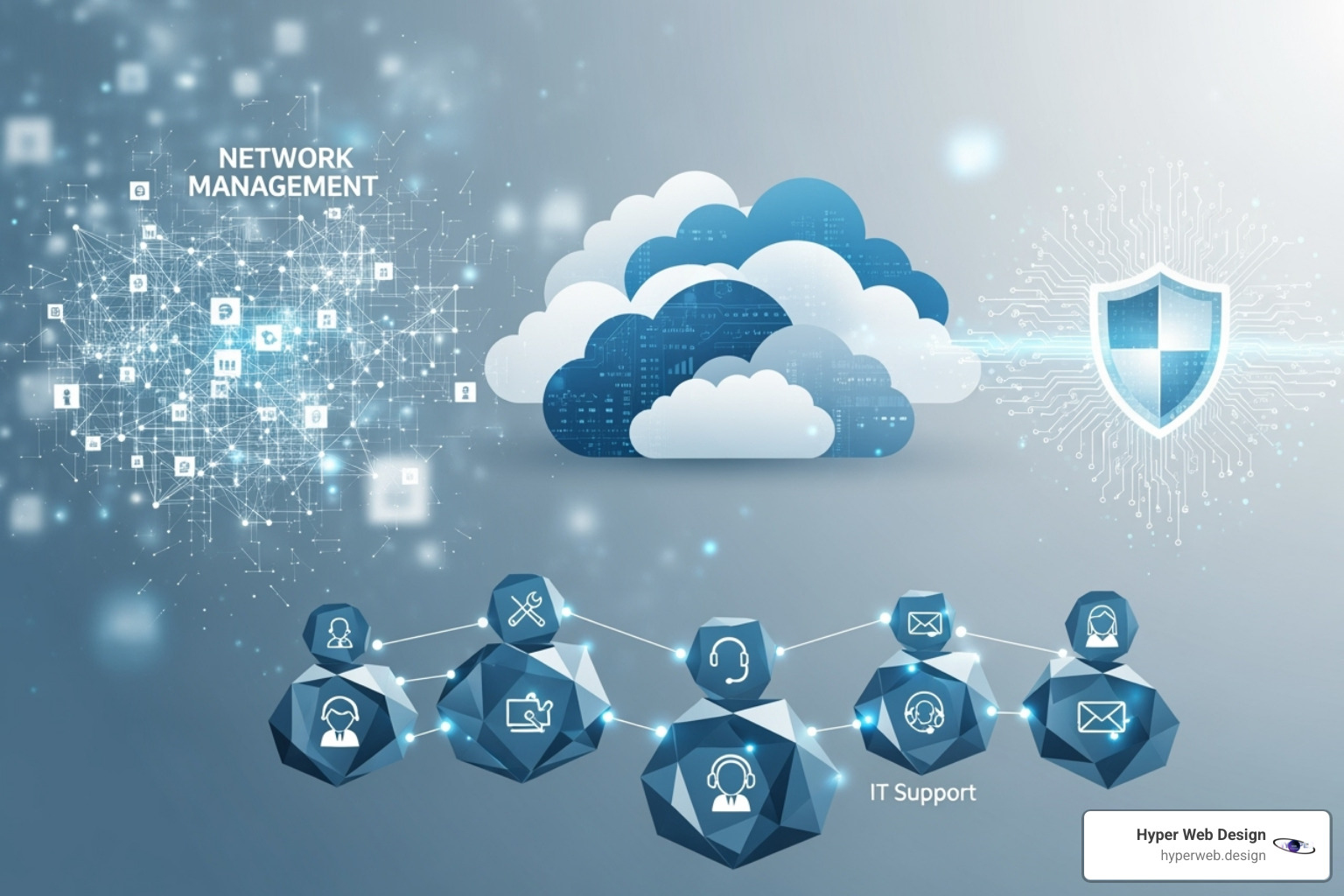IT Managed Services: Master Your IT 2025
Why IT Managed Services Matter for Modern Businesses
IT managed services are outsourced technology solutions where a third-party provider handles your business’s IT operations, monitoring, and support on a proactive basis. Here’s what you need to know:
Key Components:
- Proactive monitoring instead of waiting for problems
- 24/7 support and system maintenance
- Predictable monthly costs rather than surprise repair bills
- Expert knowledge without hiring full-time IT staff
- Focus on prevention rather than fixing broken systems
Common Services Include:
- Network monitoring and security
- Data backup and disaster recovery
- Cloud infrastructure management
- Help desk support
- Software updates and patch management
The global managed services market is growing rapidly, reflecting how businesses are moving away from the old “break/fix” model—where you only call for help when something breaks—toward proactive partnerships that prevent problems before they happen.
For any business, downtime isn’t just inconvenient—it’s devastating. A website crash or data compromise can cause irreversible damage to brand reputation. Managed IT services provide the enterprise-level security and reliability that modern businesses demand.
Small to medium-sized businesses can now access the same level of IT expertise that Fortune 500 companies have, but at a fraction of the cost of building an internal team.
I’m Shawn Shameli, and over the past decade, I’ve helped businesses transition to strategic IT managed services partnerships that drive growth and security. My experience shows how crucial reliable IT is for businesses that can’t afford downtime or security breaches.
It managed services glossary:
The Core of IT Managed Services
This section will explore the fundamental components of managed IT, from its historical roots to the tangible benefits and services businesses can expect.
From Break/Fix to Proactive Partnerships: The Evolution
In the old break/fix model, a server crash meant scrambling for a technician, waiting hours for repairs, and facing a massive, unexpected bill. This reactive approach dominated IT support for decades, leaving businesses anxious about the next technology disaster.
The story of IT managed services began in the 1990s with Application Service Providers (ASPs). These pioneers recognized businesses needed ongoing support and maintenance to prevent problems, not just fix them.
The real change occurred in the early 2000s. As business technology grew more complex, forward-thinking providers began offering comprehensive monitoring and maintenance, shifting the focus from crisis management to prevention.
The acceleration of Cloud computing allowed businesses to access enterprise-level technology without massive upfront investments, opening new possibilities for flexible, scalable support from managed service providers.
The rise in cybersecurity threats added another crucial dimension. As hackers became more sophisticated, businesses realized they needed specialized security expertise, driving growth in managed security services and making threat protection accessible to all.
At the heart of modern IT managed services lies Remote Monitoring and Management (RMM) technology. These powerful tools allow providers to watch over your systems 24/7, identifying and resolving potential issues before they become major problems.
This evolution represents a complete mindset shift. Instead of waiting for disasters, businesses now have partners focused on stability, optimization, and strategic growth. It’s the difference between a fire department and a fire prevention system.
Key Business Benefits: Efficiency, Expertise, and Focus
Partnering with IT managed services offers a strategic advantage that touches every corner of your business. These are the game-changing benefits that make this partnership so powerful.
Cost efficiency is a compelling reason for managed services. Building an in-house IT team involves high costs for salaries, benefits, and training. Managed services offer predictable monthly fees that make budgeting straightforward and eliminate surprise repair bills.
IT managed services free your team to focus on core operations. Instead of staff wrestling with server issues, they can concentrate on growing your business, from crafting exceptional products to enhancing customer experiences.
Access to specialized expertise is a major benefit. The IT landscape is vast, from cybersecurity to cloud architecture. Managed service providers bring together specialists, giving you enterprise-level expertise at a fraction of the cost of an in-house team.
Reduced downtime translates directly into protected revenue and reputation. With systems monitored around the clock, potential issues get resolved before they impact operations. This 24/7 support means someone is always watching your technology.
The built-in scalability of managed services grows with your business. A provider can adapt quickly to new employees, locations, or software without requiring major capital investments or lengthy hiring processes.
These benefits transform IT from a headache into a competitive advantage. You get predictable costs, expert knowledge, and reliable systems, freeing you to focus on business success. For more information, explore our IT support for businesses services.
Common Types of IT Managed Services
The world of IT managed services encompasses a comprehensive suite of solutions designed to keep your technology running smoothly, securely, and efficiently. While each provider may offer different packages, several core services form the foundation of effective managed IT support.
Network monitoring serves as the watchful guardian of your IT environment. This service continuously supervises your servers, networks, and devices, detecting performance issues, security threats, and potential failures before they disrupt your operations.
In today’s threat landscape, managed security is critical. Cybercriminals are more sophisticated, so businesses need robust protection beyond basic antivirus. Managed security includes firewall management, intrusion detection, threat intelligence, and incident response to protect sensitive data and ensure compliance. Our focus on secure web solutions demonstrates our commitment to digital security.
Cloud infrastructure management is crucial as businesses migrate to cloud-based solutions. Managing cloud environments like AWS, Azure, and Google Cloud requires specialized expertise. Providers help with cloud strategy, migration, and optimization to ensure your resources are cost-effective, secure, and performant.
Business Continuity and Disaster Recovery (BCDR) services protect your operations against unexpected events. Whether facing natural disasters, system failures, or cyberattacks, BCDR ensures your business can quickly recover critical data and resume operations with minimal downtime.
Data backup is a crucial component of your protection strategy. Regular, automated backups protect against ransomware, hardware failures, and human error. Modern backup solutions include multiple recovery points and fast restoration capabilities.
Help desk support provides your employees with a single point of contact for all IT-related challenges. From password resets and software troubleshooting to hardware issues, dedicated help desk services minimize employee frustration and maximize productivity.
Beyond these core offerings, many providers extend into specialized areas like managed communication services for VoIP and unified communications, managed print services to optimize printing environments, and managed data analytics to help businesses harness their information for better decision-making.
The beauty of IT managed services lies in how these different components work together seamlessly, creating a comprehensive technology ecosystem that supports your business goals while protecting your valuable assets.
Understanding Pricing Models for IT Managed Services
One of the biggest advantages of IT managed services over traditional break/fix support is cost predictability. Instead of crossing your fingers and hoping for small repair bills, managed services operate on subscription models that make budgeting straightforward and eliminate financial surprises.
Most managed service providers structure their pricing around several common models, each designed to match different business needs and preferences. Per-device pricing charges a monthly fee for each computer, server, or piece of equipment under management. This model works well for businesses that want simple, transparent pricing based on their actual technology footprint.
Per-user pricing takes a different approach, charging based on the number of employees who need IT support. This model often includes email accounts, software licenses, and help desk access for each user. It’s particularly attractive for businesses where employees use multiple devices or work remotely.
Tiered packages offer different service levels at various price points. A basic tier might include monitoring and help desk support, while premium tiers add advanced security, backup services, and priority response times. This approach lets businesses choose the level of service that matches their needs and budget.
Flat monthly fees provide the ultimate in predictability, covering all agreed-upon services for a fixed price regardless of usage. This model works especially well for businesses that want to treat IT support as a fixed operational expense, similar to rent or utilities.
Some providers offer à la carte pricing, allowing businesses to pick and choose specific services they need. While this can seem cost-effective initially, it often becomes more expensive than bundled packages and can create gaps in coverage.
The subscription model has become the gold standard for IT managed services because it aligns provider and client interests. Providers are incentivized to keep systems running smoothly to avoid service calls, while clients enjoy predictable costs and proactive support.
When evaluating pricing models, consider not just the monthly cost but the total value delivered. A slightly higher monthly fee that includes comprehensive security, backup, and monitoring often provides better value than a low-cost option that leaves critical gaps in coverage. The goal is finding a predictable IT budget that delivers the reliability and expertise your business needs to thrive.





